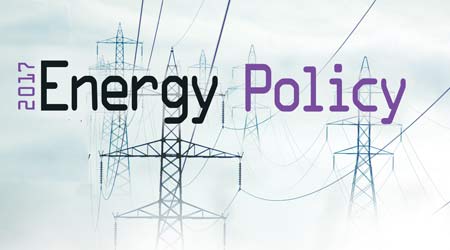Will Programs Like Energy Star, Energy Efficiency Tax Incentives Be Cut?
Second of a four-part cover story looking at how Trump Administration policy may affect energy policy for the road ahead.
One area of concern is what is going to happen at EPA and DOE, especially in terms of the potential for cuts, which could affect personnel and programming. Consider EPA’s Energy Star benchmarking tool, Portfolio Manager, which has become an embedded best practice for many facility managers and has widespread backing in the industry. “It’s something that we support and I think a perfect example of how the government can play a role in shaping the industry without doing so in a mandated approach,” says Bryant.
There has been no suggestion that the new administration will eliminate programs like Energy Star or DOE’s Better Buildings Challenge. And some think programs like Energy Star are so well-received that seeing any harm come to them is highly unlikely. What’s more, many in the industry hope that, with the president’s background in real estate, the importance of those programs will be understood. “However, if this administration takes a hatchet to budgets rather than a scalpel, I think there could be some unintended consequences for those programs,” says Bryant.
In a worst case scenario, if Portfolio Manager were no longer available, the impact would be loss of a common method to guide and justify energy efficiency investments in buildings. “The difficulty is then that everybody is going to be speaking different languages at some level relative to what efficiency looks like,” says Allan Skodowski, managing senior vice president and director of LEED and sustainability services at Transwestern. “You say you have a rating of 75 and people know what that means. There aren’t any other tools out there that allow saying that as cleanly and succinctly. It’s a tool. It’s what you use to drive investment.”
Energy use benchmarking with Energy Star’s tool has become woven into other industry initiatives, whether LEED certification or GRESB scoring, he says. (GRESB describes itself as an investor-driven organization committed to assessing the environmental, social, and governance performance of real assets globally, including real estate portfolios.) “There are a lot of things that are tied to this that ultimately come back to the money that invests in buildings,” Skodowski says. “Hopefully EPA stays intact or is given a role that allows it to grow.”
 Focusing on energy efficiency will continue to be an industry best practice regardless of what happens in Washington, says Allan Skodowski, managing senior vice president and director of LEED and sustainability services at Transwestern. “We’re still going to do what’s right by the buildings, by the ownerships, and the tenants” he says. “We’re going to continue to drive efficiency into the buildings.”
Focusing on energy efficiency will continue to be an industry best practice regardless of what happens in Washington, says Allan Skodowski, managing senior vice president and director of LEED and sustainability services at Transwestern. “We’re still going to do what’s right by the buildings, by the ownerships, and the tenants” he says. “We’re going to continue to drive efficiency into the buildings.”Impact on taxes
One way the Trump administration could have a positive impact on energy efficiency in commercial buildings is through changes to tax policies, which might benefit depreciation of equipment or infrastructure upgrades, says Layke. The question is to what extent changes in depreciation rules will produce more funding for energy efficiency and other upgrades. “I’m hopeful that a tax shift could allow us to get better depreciation rules in place and do the upgrades,” Layke says. “We have a lot of deferred maintenance on buildings that could benefit from this administration’s focus on infrastructure.”
A change in depreciation methodology could be a significant boon.
“Right now one of the things being bandied about is allowing for 100 percent depreciation on most assets and sometimes even including buildings,” says Mike Cole, senior manager of taxation, RSM, a real estate consulting firm. Generally, it is 50 percent for many assets placed in service plus the normal Modified Accelerated Cost Recovery System (MACRS) depreciation on the remaining amount. “If that happens, how are we going to change the way that commercial real estate professionals determine their return on investment?”
RSM for one is expecting to see large capital expenditures, such as new buildings, building structural improvements, or remodels of buildings, and large machinery in the first and second quarter of this year in their middle market index, Cole says.
In addition, a lot of people are expecting to see a large reduction in the corporate and pass-through tax rates, Cole says. “You are going to see people trying to take any credit and deduction that they can related to their 2016 tax return and maybe even planning in 2017, assuming the rate change happens in 2018.”
While there are no clear indicators from the federal government on significant changes to tax incentives related to energy efficiency, “what you can expect to see is people trying to maximize rate plays within an anticipated rate change,” Cole says. Facility managers looking to get in on that should consult their financial advisors post haste, as the planning has to occur about two years ahead of the rate change, he says.
The effects and opportunity of uncertainty
One impact of uncertainty around energy policy might be to create caution around pursuing certain projects. People might decide not to move forward with a project, or they might wait to make an investment, or it might be more difficult for them to convince their stakeholders that it’s a good investment, says Rachel Sowards, executive director at Paladino and Company, a real estate consulting firm. “Without energy incentives or savings incentives for certain types of upgrades, what you’re putting at risk in that situation is a project that has been planned, scheduled, funded now has to go back to the drawing board.”
On the other hand, ambiguity can also open up an opportunity for the commercial real estate industry to take a greater leadership role. “There is a tremendous opportunity at the local level for building industries broadly, whether it’s construction, management, or associations, to come into the policy conversation with a set of solutions,” says Layke. “This is a moment where actually coming forward with those solutions in absence of a federal agenda to do common sense policy could be an opportunity. If the states are going to deploy resources that the federal government may make available, we ought to be prepared to talk about what we do with that infrastructure and investment.”
Sowards says facility managers and building owners should be aware of the sorts of programs that are available on those levels that best align with their building and who specifically is advocating for what in the communities in which they own property. “Self-educating is very important right now, especially when there’s this level of ambiguity at the federal level,” she says. “Let’s get local because those are the places and relationships we can actually touch and impact.” (See “States and local jurisdictions will continue to lead on energy efficiency.”)
Staying on top of the energy story as it develops under the new administration will mean facility managers need to understand the interconnected web of energy impacts, says Sowards. “We do have this economy that is so tied to the fossil fuel industry,” she says, and gives an example of a snowstorm, which increased the demand for heating oil. This in turn drove up the price of crude, which caused the stock market to improve. The momentary higher price of oil also caused the payback on solar projects to improve and the business case for recycling plastics (instead of creating new plastics) to improve. “Being educated on the whole topic of the interconnected global economy is important,” she says.
And above all, keep calm and carry on, as the Brits say. “As a building operator, four years is a short period of time in a building’s life,” says Skodowski. “We’re going to be fine.”
Email comments to naomi.millan@tradepress.com.
Related Topics:
















